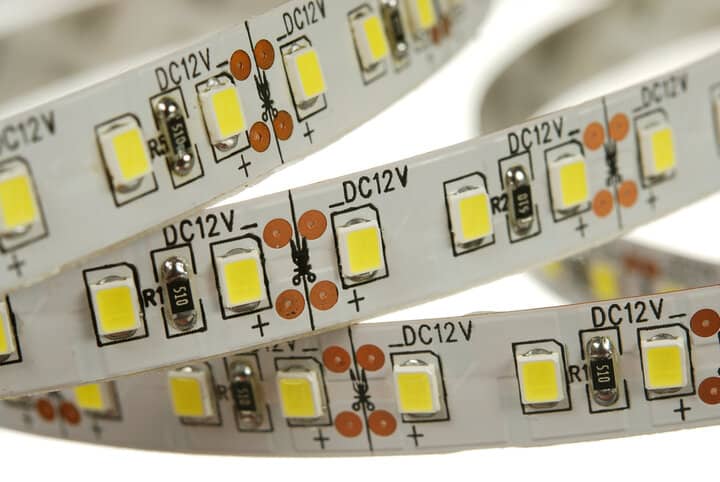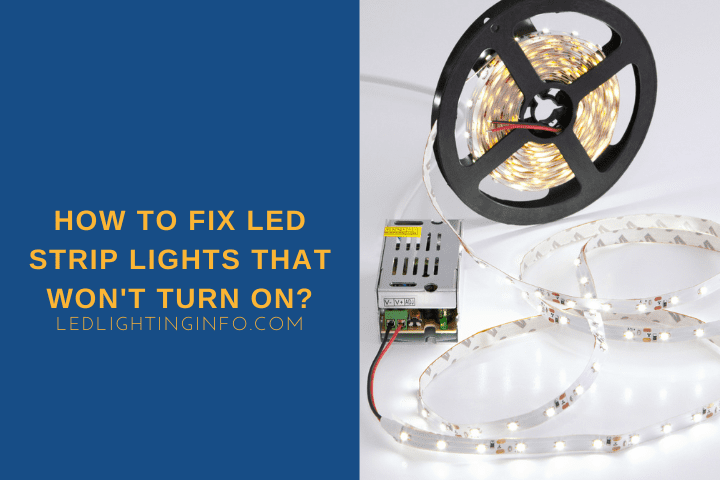While LED strip lights are a fantastic way of adding atmosphere and ambiance to a space, they aren’t the most helpful at telling you what’s wrong if they stop working and won’t turn on.
Some things might be obvious, but others can be harder to spot. And until you’ve managed to work out where the issue is, it can be frustrating.
Fixing LED strip lights depends on the issue – faulty power supplies usually need to be replaced, but issues with the lights can be fixed by adjusting connections or removing a section of faulty lights and then splicing the working sections together.
In this guide, I’ll take you through the following:
- The top reasons your LED strips aren’t turning on, and how to fix them
- Whether dim LED lights can be fixed
- How to remove a section of non-working strip lights
How To Troubleshoot LED Strips That Won’t Turn On?

Identifying the issue with your LED strip lights is often more complicated than actually fixing the problem.
You can start by narrowing down the problem, though.
LED Strip Refuses To Turn On At All
Power supply broken
If the entire LED strip doesn’t turn on, it might not be the broken strip lights but the power supply.
The best way to test it is to disconnect the power supply from the LED strip and try it with a different LED strip if you can or, failing that, a voltmeter if you have one.
If you have neither, the best thing to do would be to rule out other problems and buy a replacement power supply. They should only cost a couple of dollars, so if that doesn’t solve the issue, you won’t have wasted much money.
Loose connection
Another potential issue related to the power supply could be a problem with the connection to the strip. If it’s a DC supply with a built-in connector, this is rare – those plug-in options don’t really get loose.
But if it’s connected via solder or a clip-on connector, check that nothing has come loose, as that could be causing a lack of power.
If it has, the fix is just a re-making of that connection.
Incorrect wiring
While checking the wire connections, ensure they’re wired correctly.
This is mainly for soldered wire connections, but make sure the positive is wired to the positive and the negative terminals are connected.
If you’ve connected multiple strips in a chain, you might have accidentally installed one upside down and wired the terminals incorrectly.
Finding this is the issue is a quick fix, but there’s a chance you may have damaged the strip by wiring it incorrectly. Rewire it and try it again, but you’ll need to replace it if it doesn’t work.
Heat damage
LED strip lights don’t work well with heat. Therefore, it could have been damaged if the strip had been used in a poorly ventilated area.
Unfortunately, heat damage isn’t always apparent. Look for any ‘dirty’ marks on the strip, but scorch marks might not appear.
If you can identify that heat damage has occurred, you’ll need to replace the strip – but before, add a heat sink to make sure your next strip can be properly cooled.
Strip Lights Only Turn On Sometimes
Loose connection
Sometimes a loose connection isn’t completely separated, and your strip lights might work intermittently. Still, the weakness of the contact means that it is sometimes broken.
You need to follow the same steps as above, looking at the connections for any weak points and re-making them to fix this issue.
Remote battery
It’s always worth checking every potential cause of faulty strip lights, even if they seem obvious.
So if you use a remote control to switch your lights on and off…have you checked the battery in the lights?
The signal from the remote is weak as the battery is failing, and you need to swap it out. Most remotes for strip lights use CR lithium batteries, which only cost $1-2 to replace.
Section Of Strip Lights Won’t Turn On
Voltage drop
If a section of your strip lights won’t turn on, and it’s the section furthest from the power supply, there’s a good chance the issue is voltage drop.
This means that you’ve connected too many strip lights in sequence. The power supply can’t handle them – the voltage drops when it reaches the last section of lights, and it isn’t enough to turn them on.
The only way to fix this would be to disconnect the non-working section from the chain you’ve created and connect it to a secondary power supply or to change the circuit to run parallel from the power supply, instead of in series.
Broken section
If a section of LED strip lights isn’t working and it’s in the middle of your strip, that means you’ve got a faulty section.
I’ll explain how to fix this in more detail below.
How To Fix LED Strips That Lost Their Brightness?

If the LED strip lights you have installed are losing brightness towards the end of the circuit, that sounds like another case of voltage drop.
Again, you may have to rewire your circuit to add a secondary power supply or switch it to parallel.
But what about when the entire strip light is losing brightness?
There are two potential causes:
- A faulty power supply that no longer provides the required voltage
- The LEDs are failing
You need to check the power supply. LED strip lights will run off a 12V or 24V power supply, so use a voltmeter to check you’re getting 12 volts or 24 volts from the supply.
The power supply needs replacing if the voltage has dipped by more than 1 volt.
If the voltage is accurate, the fault lies with the strip, and you probably need to replace your lights.
You can’t repair the brightness of LEDs once they start failing.
How To Fix A Section Of LED Strip That Is Not Working?

I mentioned above that sometimes sections of LED strips will fail in the middle of a run of lights, even if the lights on either side work fine.
You ideally don’t want to replace the whole strip when some of the lights are working, so what can you do?
Usually, the best solution is to remove the non-working section and then splice the working sides together.
This is possible on most LED strip lights because special cutting areas are designed to cut the strip lights without damaging the circuit.
Look for a dashed or solid cutting line on your strip lights, and make sure you cut only through this line.
Do so on both sides to remove the faulty LED section.
You can then connect the working sides using a strip light connector, or using soldered wire if you prefer.
Final Words
There are quite a few different problems that can affect your strip lights, but the good news is that some can be rectified without completely removing and replacing them.
Unfortunately, if you’ve bought cheap LEDs, they are more liable to failure, and sometimes you can do nothing to save them.
And, of course, even good-quality ones will burn out eventually.
But work through this guide if your strip lights won’t turn on, as you can save time and effort by fixing a common issue instead of buying entirely new lights.
Have you ever had issues with your strip lights not switching on, and if so, how did you fix it?


